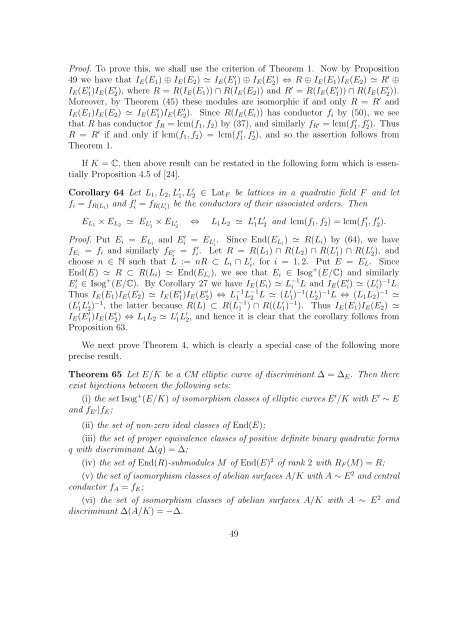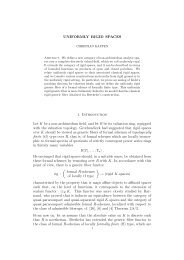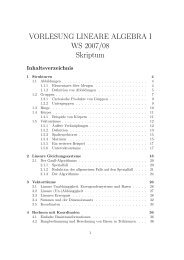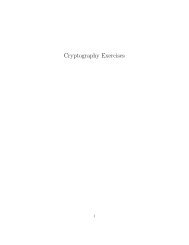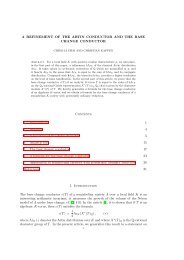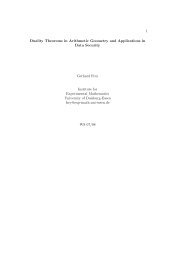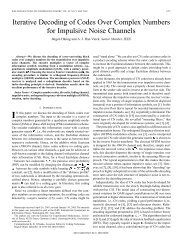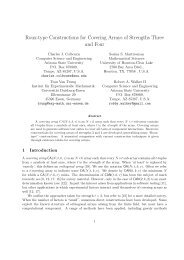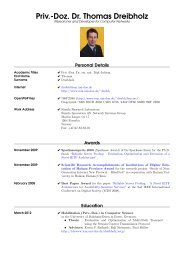for some regular left ideal I <strong>of</strong> End(E n ). Thus A ≃ EH(I) n . Furthermore, by the abovecomputation we have Z((I : I)) = R, and so I is in the set defined by condition (iv ′ ).Remark 62 (a) It is sometimes useful to have a direct description <strong>of</strong> the bijectionbetween the sets defined by conditions (i) and (v) <strong>of</strong> Theorem 5. Indeed, if we unravelthe bijections constructed in the pro<strong>of</strong> <strong>of</strong> Theorem 5, then we obtain that this bijectionis given by the rule (E ′ ; f 1 , . . . , f n−2 ) ↦→ A(E ′ ; f 1 , . . . , f n−2 ; E), where(102)A(E ′ ; f 1 , . . . , f n−2 ; E) := E ′ × E 1 × . . . × E n−2 × E,where E i = E H(fE R i ) and f Ri = f i . To verify this, note first that the bijection is givenby ϕ 5 ◦ ϕ 4 ◦ µ R,n ◦ ϕ 1 in the notation <strong>of</strong> the pro<strong>of</strong> <strong>of</strong> Theorem 5. Thus, if we put I 1 =I E (E ′ ), I i+1 = f E R i for i = 1, . . . , n−2 and I n = R, then µ R,n (ϕ 1 ϕ 1 (E ′ , f 1 , . . . , f n−2 ) =I 1 ⊕ . . . ⊕ I n . On the other hand, ϕ 5 (ϕ 4 (I 1 ⊕ . . . ⊕ I n )) = ϕ 5 ((I 1 : . . . : I n )) =E H(I1 ) × . . . × E H(In ) by Proposition 41, and so the assertion follows.(b) The bijections <strong>of</strong> Theorem 5 yield immediately a classification <strong>of</strong> all abelianvarieties A ∼ E n with f A |f E . More precisely, we have natural bijections between thefollow sets:(i) The set <strong>of</strong> sequences (E ′ ; f 1 , . . . , f n−1 ) where E ′ ∼ E is an isomorphism class<strong>of</strong> <strong>elliptic</strong> <strong>curves</strong> with f E ′|f E and the f i ’s are positive integers with f E ′|f 1 | . . . |f n−1 |f E .(ii) the set <strong>of</strong> sequences (I; f 1 , . . . , f n−1 ) where I is an isomorphism class <strong>of</strong> nonzeroEnd(E)-ideals whose order R(I) has conductor f R(I) |f 1 | . . . |f n−1 |f E .(iii) the set <strong>of</strong> sequences (q; c 1 , . . . , c n−2 ) where q is a proper equivalence class <strong>of</strong>positive binary quadratic forms <strong>of</strong> discriminant ∆(q) = ∆/m 2 , for some m ∈ N, andc 1 | . . . |c n−2 |cont(q).n;(iv) the set <strong>of</strong> isomorphism classes <strong>of</strong> End(E)-submodules M <strong>of</strong> End(E) n <strong>of</strong> rank(v) the set <strong>of</strong> isomorphism classes <strong>of</strong> abelian varieties A ∼ E n with central conductorf A |f E .4.4 Abelian product surfacesWe now specialize the previous results to the case <strong>of</strong> abelian surfaces, i.e. to the casen = 2. In particular, we shall prove Theorem 4 and show how the results <strong>of</strong> Shiodaand Mitani[24] follow from the above theorems.We begin with the following refinement <strong>of</strong> Theorem 1 (in the case n = 2) which isclosely related to Proposition 4.5 <strong>of</strong> [24].Proposition 63 Let E 1 , E 2 , E 1, ′ E 2 ′ ∈ Isog + (E/K), where E/K is a <strong>CM</strong> <strong>elliptic</strong> curve,and put f i = f Ei and f i ′ = f E ′i. Then E 1 × E 2 ≃ E 1 ′ × E 2 ′ if and only iflcm(f 1 , f 2 ) = lcm(f ′ 1, f ′ 2) and I E (E 1 )I E (E 2 ) ≃ I E (E ′ 1)I E (E ′ 2).48
Pro<strong>of</strong>. To prove this, we shall use the criterion <strong>of</strong> Theorem 1. Now by Proposition49 we have that I E (E 1 ) ⊕ I E (E 2 ) ≃ I E (E 1) ′ ⊕ I E (E 2) ′ ⇔ R ⊕ I E (E 1 )I E (E 2 ) ≃ R ′ ⊕I E (E 1)I ′ E (E 2), ′ where R = R(I E (E 1 )) ∩ R(I E (E 2 )) and R ′ = R(I E (E 1)) ′ ∩ R(I E (E 2)).′Moreover, by Theorem (45) these modules are isomorphic if and only R = R ′ andI E (E 1 )I E (E 2 ) ≃ I E (E 1)I ′ E (E 2).′ Since R(I E (E i )) has conductor f i by (50), we seethat R has conductor f R = lcm(f 1 , f 2 ) by (37), and similarly f R ′ = lcm(f 1, ′ f 2). ′ ThusR = R ′ if and only if lcm(f 1 , f 2 ) = lcm(f 1, ′ f 2), ′ and so the assertion follows fromTheorem 1.If K = C, then above result can be restated in the following form which is essentiallyProposition 4.5 <strong>of</strong> [24].Corollary 64 Let L 1 , L 2 , L ′ 1, L ′ 2 ∈ Lat F be lattices in a quadratic field F and letf i = f R(Li ) and f ′ i = f R(L ′i ) be the conductors <strong>of</strong> their associated orders. ThenE L1 × E L2 ≃ E L ′1× E L ′2⇔ L 1 L 2 ≃ L ′ 1L ′ 2 and lcm(f 1 , f 2 ) = lcm(f ′ 1, f ′ 2).Pro<strong>of</strong>. Put E i = E Li and E i ′ = E L ′i. Since End(E Li ) ≃ R(L i ) by (64), we havef Ei = f i and similarly f E ′i= f i. ′ Let R = R(L 1 ) ∩ R(L 2 ) ∩ R(L ′ 1) ∩ R(L ′ 2), andchoose n ∈ N such that L := nR ⊂ L i ∩ L ′ i, for i = 1, 2. Put E = E L . SinceEnd(E) ≃ R ⊂ R(L i ) ≃ End(E Li ), we see that E i ∈ Isog + (E/C) and similarlyE i ′ ∈ Isog + (E/C). By Corollary 27 we have I E (E i ) ≃ L −1i L and I E (E i) ′ ≃ (L ′ i) −1 L.Thus I E (E 1 )I E (E 2 ) ≃ I E (E 1)I ′ E (E 2) ′ ⇔ L −11 L −12 L ≃ (L ′ 1) −1 (L ′ 2) −1 L ⇔ (L 1 L 2 ) −1 ≃(L ′ 1L ′ 2) −1 , the latter because R(L) ⊂ R(L −11 ) ∩ R((L ′ 1) −1 ). Thus I E (E 1 )I E (E 2 ) ≃I E (E 1)I ′ E (E 2) ′ ⇔ L 1 L 2 ≃ L ′ 1L ′ 2, and hence it is clear that the corollary follows fromProposition 63.We next prove Theorem 4, which is clearly a special case <strong>of</strong> the following moreprecise result.Theorem 65 Let E/K be a <strong>CM</strong> <strong>elliptic</strong> curve <strong>of</strong> discriminant ∆ = ∆ E . Then thereexist bijections between the following sets:(i) the set Isog + (E/K) <strong>of</strong> isomorphism classes <strong>of</strong> <strong>elliptic</strong> <strong>curves</strong> E ′ /K with E ′ ∼ Eand f E ′|f E ;(ii) the set <strong>of</strong> non-zero ideal classes <strong>of</strong> End(E);(iii) the set <strong>of</strong> proper equivalence classes <strong>of</strong> positive definite binary quadratic formsq with discriminant ∆(q) = ∆;(iv) the set <strong>of</strong> End(R)-submodules M <strong>of</strong> End(E) 2 <strong>of</strong> rank 2 with R F (M) = R;(v) the set <strong>of</strong> isomorphism classes <strong>of</strong> abelian surfaces A/K with A ∼ E 2 and centralconductor f A = f E ;(vi) the set <strong>of</strong> isomorphism classes <strong>of</strong> abelian surfaces A/K with A ∼ E 2 anddiscriminant ∆(A/K) = −∆.49
- Page 1: Products of CM elliptic curves1 Int
- Page 7 and 8: Indeed, if If is a kernel ideal, th
- Page 9 and 10: Indeed, by (18) we have I 1 f = I 2
- Page 11 and 12: Proof. To prove (29), let h ∈ Hom
- Page 13 and 14: 2.4 The quadratic caseWe now specia
- Page 15 and 16: ecause here f 2 |f 1 , so f = f 2 a
- Page 17 and 18: For this, put f = [R ′ : R], I =
- Page 19 and 20: From (54) we can conclude that(55)d
- Page 21 and 22: If H is any finite subgroup scheme
- Page 23 and 24: E. As we shall see, it is very illu
- Page 25 and 26: From this we see on the one hand th
- Page 27 and 28: Proposition 30 Let L ∈ Lat F , wh
- Page 29 and 30: (b) Deuring[10], p. 263. Note that
- Page 31 and 32: integral quadratic formq L,α,β (x
- Page 33 and 34: Corollary 39 Let E 1 /K and E 2 /K
- Page 35 and 36: Proof. Write π i = π Hi : A → A
- Page 37 and 38: (a) The order R is cyclic if and on
- Page 39 and 40: for k = 1, . . . , n − 2. Moreove
- Page 41 and 42: 4.3 Products of CM elliptic curvesW
- Page 43 and 44: Corollary 56 Let E/K be a CM ellipt
- Page 45 and 46: Case 2. char(K) = 0.As was mentione
- Page 47: Let h A/K (X) ∈ Z[X] (respectivel
- Page 51 and 52: where xy denotes the quadratic form
- Page 53 and 54: denote the set of isomorphism class


